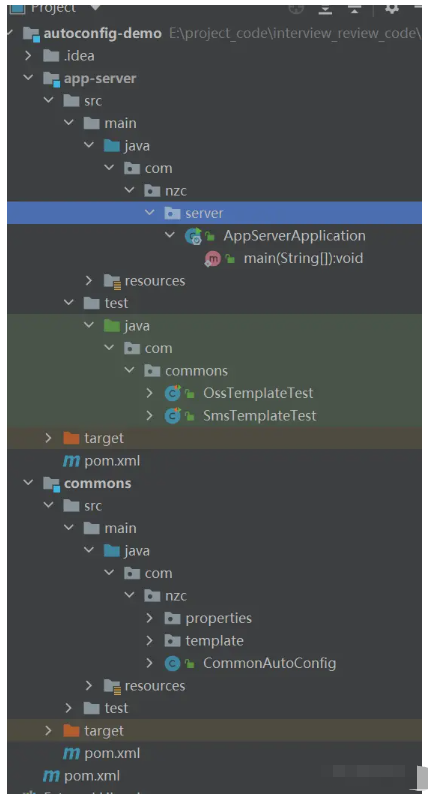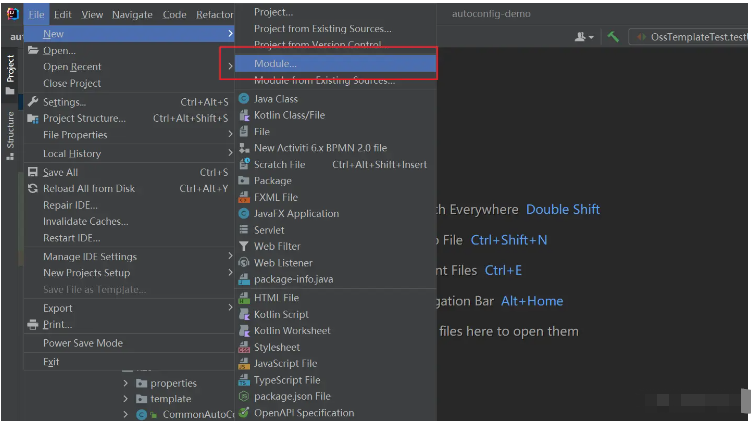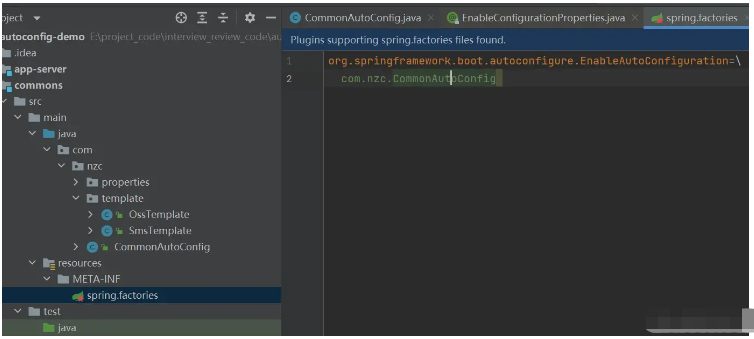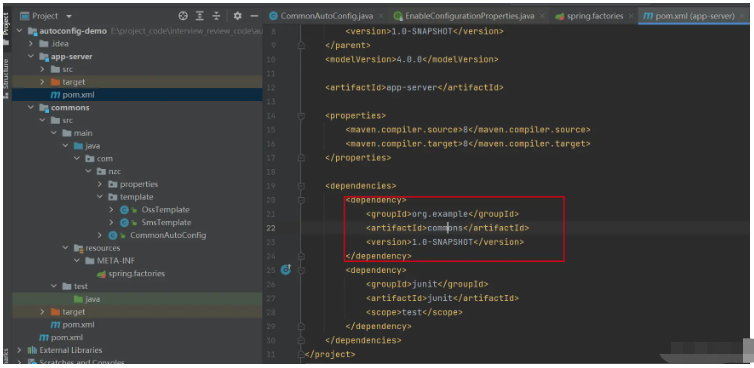
spi とは何ですか? 正式名は Service Provider Interface です。簡単に言うと、これはサービス プロバイダー インターフェイスであり、サービス実装を見つけるためのメカニズムです。
実際、これは標準定義、または実装標準です。
人生の例として、Xiaomi の携帯電話を購入するとします。
ただし、使用する充電器は Xiaomi 製である必要はなく、プロトコル、ポート、その他の要件を満たしていれば、他のメーカーの充電器を使用して充電することもできます。これもホットスワップ可能なアイデアですが、修正されていません。
これはコードの点でも同じです。インターフェイスを定義しましたが、実装クラスを変更したい場合は変更する必要があるため、特定の実装クラスを修正したくありませんでした。ソースコードですが、これは不可能な場合が多いです。
そうすれば、仕様を定義することもできます。後で実装クラスを変更したり、他の実装クラスを追加したりする必要がある場合は、この仕様に準拠します。また、これらの実装クラスを動的に検出することもできます。
SpringBoot では、現在の SpringBoot プラットフォームでいくつかの規範と標準が定義されていますが、今度は SpringBoot プラットフォームに受け入れてもらいたいと考えています。
どうすればいいですか?
これは非常に簡単で、その標準と仕様に従って物事を行うだけです。
SpringBoot が起動すると、すべての jar パッケージresource/META-INF/spring.factories ファイルがスキャンされ、完全修飾名に基づいて Bean# へのリフレクション メカニズムが使用されます。 ##コンテナにロードします。 2. カスタム スターター
このスターターでは、
を実装します。
 2.1. Maven プロジェクトを準備します
2.1. Maven プロジェクトを準備します
次に 2 つの Maven プロジェクトを作成します(私は個人的に習慣として空の Maven プロジェクトを作成することに慣れていますが、実際には SpringBoot プロジェクトの作成にも同じことが当てはまります)
 最も外側の pom.xml
最も外側の pom.xml
<parent>
<groupId>org.springframework.boot</groupId>
<artifactId>spring-boot-starter-parent</artifactId>
<version>2.5.2</version>
<relativePath/>
</parent>
<properties>
<maven.compiler.source>8</maven.compiler.source>
<maven.compiler.target>8</maven.compiler.target>
</properties>
<dependencies>
<dependency>
<groupId>org.projectlombok</groupId>
<artifactId>lombok</artifactId>
</dependency>
<dependency>
<groupId>org.springframework.boot</groupId>
<artifactId>spring-boot-starter-web</artifactId>
</dependency>
<dependency>
<groupId>org.springframework.boot</groupId>
<artifactId>spring-boot-starter</artifactId>
</dependency>
<dependency>
<groupId>org.springframework.boot</groupId>
<artifactId>spring-boot-starter-test</artifactId>
</dependency>
<dependency>
<groupId>org.springframework.boot</groupId>
<artifactId>spring-boot-configuration-processor</artifactId>
<optional>true</optional>
</dependency>
</dependencies>2.2. プロパティ クラスの準備
/**
* @author Ning Zaichun
*/
@Data
@ConfigurationProperties(prefix = "nzc.oss")
public class OssProperties {
private String accessKey;
private String secret;
private String bucketName;
private String url;
private String endpoint;
} @Data
@ConfigurationProperties(prefix = "nzc.sms")
public class SmsProperties {
private String name;
}2.3. 注入するクラスの準備
ここに OssTemplate と SmsTemplate
/**
* @author Ning Zaichun
*/
public class OssTemplate {
private OssProperties ossProperties;
public OssTemplate(OssProperties ossProperties) {
this.ossProperties = ossProperties;
}
public String test() {
System.out.println(ossProperties.getBucketName());
return "test";
}
public String upload(String filename, InputStream is) {
// yourEndpoint填写Bucket所在地域对应的Endpoint。以华东1(杭州)为例,Endpoint填写为https://oss-cn-hangzhou.aliyuncs.com。
String endpoint = ossProperties.getEndpoint();
// 阿里云主账号AccessKey拥有所有API的访问权限,风险很高。强烈建议您创建并使用RAM账号进行API访问或日常运维,请登录 https://ram.console.aliyun.com 创建RAM账号。
String accessKeyId = ossProperties.getAccessKey();
String accessKeySecret = ossProperties.getSecret();
// 创建OSSClient实例。
OSS ossClient = new OSSClientBuilder().build(endpoint, accessKeyId, accessKeySecret);
String storePath = new SimpleDateFormat("yyyy/MM/dd").format(new Date()) + "/" + UUID.randomUUID() + filename.substring(filename.lastIndexOf("."));
System.out.println(storePath);
// 依次填写Bucket名称(例如examplebucket)和Object完整路径(例如exampledir/exampleobject.txt)。Object完整路径中不能包含Bucket名称。
ossClient.putObject(ossProperties.getBucketName(), storePath, is);
String url = ossProperties.getUrl() + storePath;
// 关闭OSSClient。
ossClient.shutdown();
return url + "#" + storePath;
}
public void remove(String fileUrl) {
// yourEndpoint填写Bucket所在地域对应的Endpoint。以华东1(杭州)为例,Endpoint填写为https://oss-cn-hangzhou.aliyuncs.com。
String endpoint = ossProperties.getEndpoint();
// 阿里云账号AccessKey拥有所有API的访问权限,风险很高。强烈建议您创建并使用RAM用户进行API访问或日常运维,请登录RAM控制台创建RAM用户。
String accessKeyId = ossProperties.getAccessKey();
String accessKeySecret = ossProperties.getSecret();
// 填写Bucket名称。
String bucketName = ossProperties.getBucketName();
// 填写文件完整路径。文件完整路径中不能包含Bucket名称。
//2022/01/21/f0870eb3-4714-4fae-9fc3-35e72202f193.jpg
String objectName = fileUrl;
// 创建OSSClient实例。
OSS ossClient = new OSSClientBuilder().build(endpoint, accessKeyId, accessKeySecret);
// 删除文件或目录。如果要删除目录,目录必须为空。
ossClient.deleteObject(bucketName, objectName);
// 关闭OSSClient。
ossClient.shutdown();
}
} public class SmsTemplate {
private SmsProperties properties;
public SmsTemplate(SmsProperties properties) {
this.properties = properties;
}
public void sendSms(String mobile, String code){
System.out.println(properties.getName()+"=="+mobile+"===="+code);
}
}2.4、AutoConfiguration
@EnableConfigurationProperties({
SmsProperties.class,
OssProperties.class
})
public class CommonAutoConfig {
@Bean
public SmsTemplate smsTemplate(SmsProperties smsProperties){
return new SmsTemplate(smsProperties);
}
@Bean
public OssTemplate ossTemplate(OssProperties ossProperties){
return new OssTemplate(ossProperties);
}
}META-INF フォルダーの下に spring.factories ファイルを作成します。
内容は
org.springframework.boot.autoconfigure.EnableAutoConfiguration=\ com.nzc.CommonAutoConfig
org.springframework.boot.autoconfigure.EnableAutoConfiguration=\
com.nzc.CommonAutoConfig \
com.xxx.xxx
#このステップに到達したら、このプロジェクトの Jar パッケージを作成し、それを使用するプロジェクトに導入します。 
#2.6. アプリケーションのテスト
spring:
application:
name: app-server
nzc:
sms:
name: ningzaichun
oss:
accessKey: xxx
secret: xxx
endpoint: oss-cn-shenzhen.aliyuncs.com
bucketName: xxx
url: xxxテスト クラスを作成します:
@RunWith(SpringRunner.class)
@SpringBootTest(classes = AppServerApplication.class)
public class TemplateTest {
@Autowired
private OssTemplate ossTemplate;
@Test
public void testOss(){
String s = ossTemplate.test();
System.out.println(s);
}
@Test
public void testUpload(){
try {
File file = new File("D:\evectionflow01.png");
InputStream inputStream = new FileInputStream(file);
ossTemplate.upload("123.jpg",inputStream);
} catch (FileNotFoundException e) {
e.printStackTrace();
}
}
@Autowired
private SmsTemplate smsTemplate;
@Test
public void testSendSms(){
smsTemplate.sendSms("17670090715","123456");
}
}以上がSpringBoot SPI メカニズムとカスタム スターターを実装する方法の詳細内容です。詳細については、PHP 中国語 Web サイトの他の関連記事を参照してください。